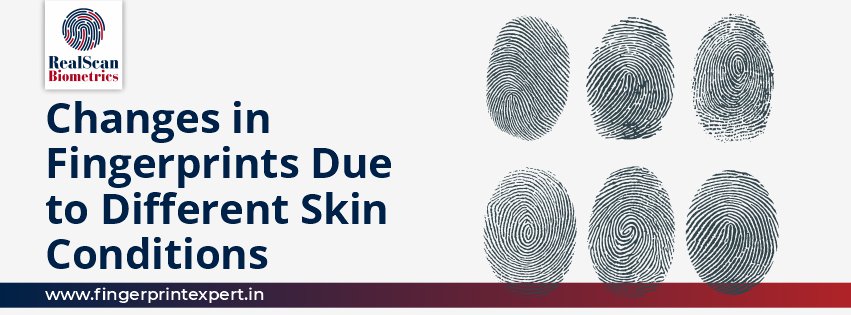As we all know the fingerprint is the unique feature of all human beings which helps to distinguish people from each other and no one can alter or change it.
What can Cause Fingerprints to Change?
Physical conditions like allergy to some objects, powder, plants, food etc., can lead to change in fingerprints.
They can also change due to some climatic changes like high temperature, high humidity etc.
Also, there are a few temporary and permanent changes which can alter the changes in fingerprint skin, like alterations caused due by technical errors while using a biometric system and while using devices with dirty fingers, sweaty hands etc.
Then there are different diseases which may also be responsible for the changes and may affect the clarity of your fingerprints. These diseases can cause loss of fingerprint or absence of fingerprint while collection.
In special conditions there can be an alteration of fingerprint due to any kind of deformity of disease which leads to abruption in the pattern and loss of fingerprint.
Furthermore, the fingerprint doesn’t change naturally, over time as opposed, to other physical features that may change owning various factors.
Fingerprint recognition is influenced by skin diseases and these changes in prints can affect background checks for immigration, national registrations, banking transactions, biometric recognition, and other set of things.
So those people are excluded from this method and other means of verification are employed which are however less secure and more cumbersome.
Skin regenerates on a continuous basis.
A skin cell begins its existence in the dermis's lowest layer (the base layer), which is rich in blood vessels and nerve endings.
The cell migrates upward for roughly two weeks until it reaches its destination and penetrates the epidermis the lowest layer.
The epidermis doesn’t have blood vessels, but it does have nerve endings.
The cells proceed through a sequence in the modification in the epidermis for another two weeks and progressively become more mature.
After flattering out and approaching the surface, it expires and shed its skin.
The following are six skin functions: sensation, temperature control, the act of absorbing, safeguarding, excretion and secretion.
There are different types of diseases like Hand eczema, fingertip eczema, Pompholyx, Pyoderma, Pitted keratolysis, Keratolysis exfoliativa, Lichen planus, pyogenic granuloma, systemic sclerosis, Raymanud's phenomenon, drug-induced skin reactions, leprosy, herpes-simplex virus, scabies, erythema multiforme.
These are some diseases that can occur in epidermis and dermis layer.
Also, dermatoglyphics is a disease in which you do not have fingerprints.
Though it is nearly impossible and less practiced system to alter a fingerprint through surgery.
However, in a case reported in America in which a person tried to alter his prints using the chemotherapy medicines.
Also in aged people, we can find out some changes in fingerprints due to occupational scars and a few common type of skin diseases like congenial Deformity, cellulitis, paronychia, rheumatoid Arthritis, psoriasis, eczema, Dupuytren contracture, leprosy, blisters.
These are diseases causing histopathological changes of epidermis and dermis.
The sweaty hand is the other reason for fingerprint errors.
To tackle the issue of false rejections and false acceptance is a challenge.
False rejection is commonly due to some superficial injuries occurring due to the minor cuts, bruises scratches and swelling that could temporarily affect the fingerprints. In a few weeks the ridges will be restored to the original shape but when the injuries on the finger are severe, then it may permanently disable the fingerprint match.
Besides the accidental injuries and the wounds, certain ailments might also hamper the proper induction through the fingers. Even if the fingerprint changes temporarily (due to wounds or bruising), it returns after the finger recovers.
Soon criminals became aware of this and began to device means to get around the identification systems. They employed several methods to alter prints like burning the fingertip skin ( fire acid or another corrosive agent), or by employing plants, it is possible to remove, change, or even fake fingerprints ( made of glue latex, silicon ), and surgery ( totally altering the skin, creating a pattern alteration- sections of skin are removed from a finger grafted back in different places, such as rotation or “Z" cuts, transplantations of an area from other parts of the body such as other fingers, palms, toes, and sole but these are less practised due to high risk and pain).
Skin diseases have a great negative impact on the fingerprint recognition process and cause problems for people suffering from skin diseases.
These people are discriminated against because they cannot use the fingerprint recognition system that is very common today.
Currently, there is no database of fingerprints affected by skin diseases.
As the first step in this extensive and complex research, a special sickle fingerprint collection station is designed and developed.
Through this station, medical experts captured the first version of this special fingerprint database.
Changes in dermatoglyphics and fingerprints may have serious medical-legal effects. In this case, the treating physician's proof of the condition seems to be a way to save the patient from any inconvenience.
At the same time, doctors and forensic experts must be cautious, especially when the well-known criminals spare no effort to change their fingerprints to hide their identities.

 October 24, 2022 - BY RealScan Biometrics
October 24, 2022 - BY RealScan Biometrics
